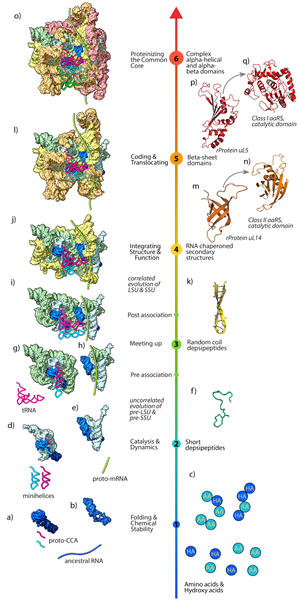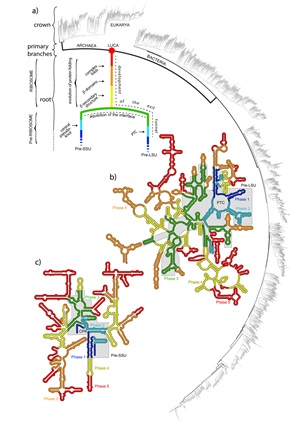Abstract:
The ribosome remembers the origins of life. We have developed a three-dimensional
comparative method that allows us to visualize the evolution of the ribosome at the molecular
level. We observe that the ribosome evolved by accretion, recursively adding rRNA segments,
iteratively growing and ‘freezing’. The ribosome has recorded its history in close analogy with
records kept by tree growth rings and geological strata. The ribosome recorded the genesis of
protein folding. The data support a model in which aboriginal polypeptides evolved into globular
proteins in a hierarchical process. (i) Short random coil peptides (or proto-peptides) bound to
rRNA, and (ii) lengthened over time and coalesced into β-β secondary elements. Polypeptide
secondary elements (iii) accreted and collapsed, primarily into β-domains. Domains (iv)
accumulated and gained complex super-secondary structures composed of mixtures of a-helices
and b-strands. Protein evolution was guided and accelerated by interactions with rRNA. The
ribosome also reveals the genesis of RNA folding. Aboriginal polynucleotides evolved into
globular RNAs in a hierarchical process. The most ancient rRNA is non-helical and tends not
form Watson-Crick base pairs. Functionality of the ribosome accreted along with structure. In
sum, the concepts of mutualism can be extended to molecules and are seen to apply to the
relationship between RNA and protein within the ribosome. The ribosome tells us that RNA and
protein arose by co-evolution as a mutualism pair.
Speaker: Prof. Loren Williams, School of Chemistry and Biochemistry, Georgia Institute of Technology
Date: 25 October, 15:30-16:30 at Mishima Hall (ELSI-1)
Host: Eric Smith
The ribosome remembers the origins of life. We have developed a three-dimensional
comparative method that allows us to visualize the evolution of the ribosome at the molecular
level. We observe that the ribosome evolved by accretion, recursively adding rRNA segments,
iteratively growing and ‘freezing’. The ribosome has recorded its history in close analogy with
records kept by tree growth rings and geological strata. The ribosome recorded the genesis of
protein folding. The data support a model in which aboriginal polypeptides evolved into globular
proteins in a hierarchical process. (i) Short random coil peptides (or proto-peptides) bound to
rRNA, and (ii) lengthened over time and coalesced into β-β secondary elements. Polypeptide
secondary elements (iii) accreted and collapsed, primarily into β-domains. Domains (iv)
accumulated and gained complex super-secondary structures composed of mixtures of a-helices
and b-strands. Protein evolution was guided and accelerated by interactions with rRNA. The
ribosome also reveals the genesis of RNA folding. Aboriginal polynucleotides evolved into
globular RNAs in a hierarchical process. The most ancient rRNA is non-helical and tends not
form Watson-Crick base pairs. Functionality of the ribosome accreted along with structure. In
sum, the concepts of mutualism can be extended to molecules and are seen to apply to the
relationship between RNA and protein within the ribosome. The ribosome tells us that RNA and
protein arose by co-evolution as a mutualism pair.
Speaker: Prof. Loren Williams, School of Chemistry and Biochemistry, Georgia Institute of Technology
Date: 25 October, 15:30-16:30 at Mishima Hall (ELSI-1)
Host: Eric Smith


